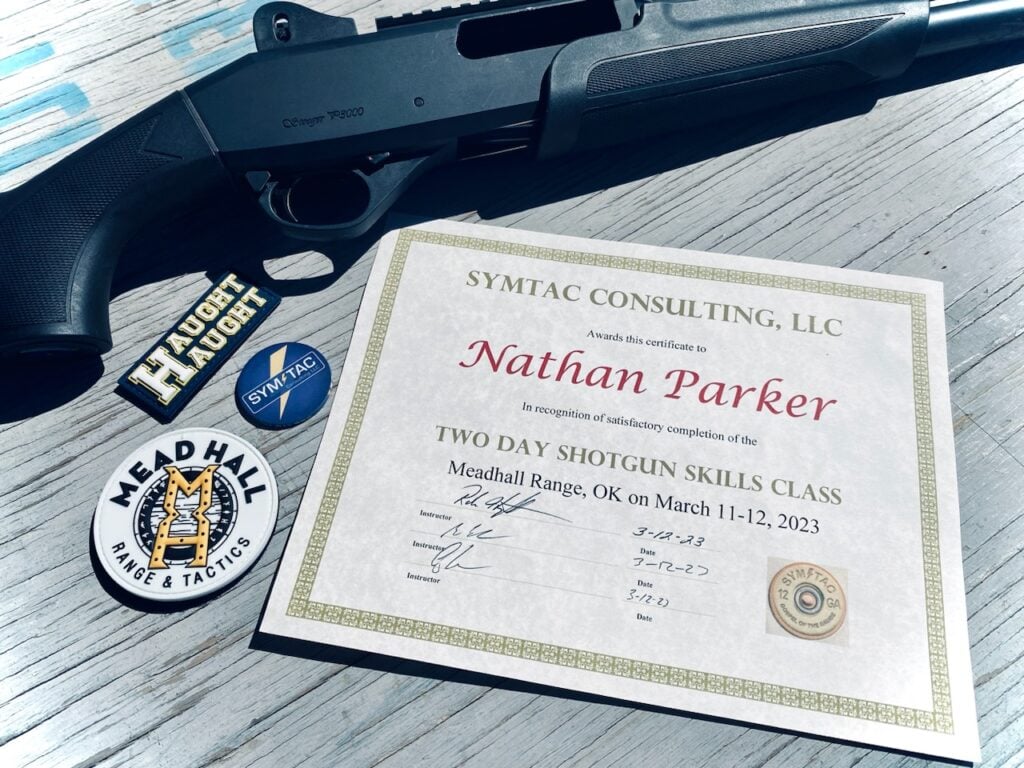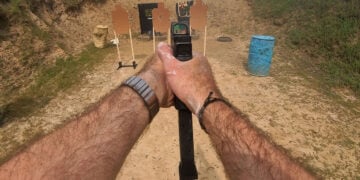If you have run in defensive shotgun circles for very long, you have probably heard the name, Rob Haught. If the combative shotgun world had a Yoda, Rob would be the guy. He grew up as an instructor in the shadow of Ken Hackathorn and ultimately pursued a career in local law enforcement.
Rob has shooting and instructional experience beyond the shotgun, but his approach to the shotgun is what really launched him into the training world. Rob and his approach to the shotgun became the basis for the shotgun training program of a large federal agency. That wave carried Rob around the country, teaching federal law enforcement personnel how to best utilize the gun.
The Symtac Consulting Shotgun Skills course is a direct descendent of the material that Rob was teaching to law enforcement personnel when shotguns were the primary long gun of the police officer. The material has, of course, evolved over time, but the lineage can be traced to those programs.
 The Facility
The Facility
While Symtac Consulting teaches shotgun classes all around the country, I would be remiss if I did not also mention the host facility for this class. Meadhall Range is about a half hour east of Oklahoma City, OK. It is one of the best-run private firearms training facilities I have been to. Bill Armstrong, who owns and operates Meadhall Range, focuses on hosting outside instructors and providing the best training experience he can for those attending the courses. He has a great classroom facility and an equally impressive outdoor range for live fire classes.
Bill hosts an impressive list of instructors. If there is someone on your radar to train with, it is worth checking to see if Bill has them on the schedule at Meadhall and trying to make the trip. The nearly unlimited supply of chocolate chip cookie bars and freeze-dried pickles are worth the effort, trust me. The class and shooting guns part is just a bonus.
Class Size and Instructor Ratios
This particular class had 17 students in attendance. With really large class sizes, students can sometimes get lost in the shuffle and not receive much attention from the instructor. Rob knows the game well, though, and made sure to bring some help.
His son Matt Haught was the primary AI for the class, coaching shooters on the line and occasionally calling the drills. I was fortunate enough to meet Matt at the Rangemaster Shotgun IDC I attended in 2021 and experienced his ability to coach shooters then. The short version is he is really good at it. He has a perceptive eye for making corrections, explains the rationale behind technique well, and is really adept at dropping that little bit of encouragement at just the right moment to keep you pushing hard. When you succeed, he is one of the first to point it out and congratulate your success. Matt is the true hidden gem of this program.
Rob also brought along Gary Powers and had help from the range operator Bill Armstrong and his helper, Michael LaBonte. Throughout the class, I received constructive feedback from all of them at one point or another. With the class split into two relays of 8 and 9 shooters and with 4 or 5 instructors working the line at a time, there was plenty of attention to go around for spotting mistakes and making corrections.
The Core Components
The primary complaint people have about shotguns is the amount of recoil that they produce and how abusive they are to the shooter. Learning Rob’s approach to recoil mitigation is step number one in this class. The very first demos and drills are focused on getting a handle on what Rob calls push/pull. Essentially, stretching the gun apart just as the shot breaks. A good portion of the first day is spent strictly working on this technique of recoil mitigation.
The other primary component of the course is learning to apply what most people call “short stocking” or “short sticking” the shotgun. It is a close-quarters shooting technique where the stock of the shotgun is rotated and raised over the top of the shoulder. This allows the gun to be drawn further back than usual. Instead of my explaining it here with my meager words, let me point you to Chris Baker at Lucky Gunner Ammo and his video on the technique.
Combined with the push/pull recoil mitigation technique, these two make for a good pairing that allows the shotgun to be more efficiently worked in tight spaces.
The Material That Weaves Around the Core
While recoil mitigation and short stocking are the stars of the show, there is a lot of other material tossed into the stew to add flavor. Reloading techniques and ammunition management, pivots, and turns, shooting on the move, multiple targets, it is all there. Some of that material is fairly universal, and if you have had exposure to it in other “operator” type classes, it will likely be familiar. In the context of this class, it adds task complexity and confirms application of the foundational skill of recoil mitigation under varied circumstances and while task loaded. If you are new to that sort of thing, you will get a healthy dose of it under the watchful eye of skilled instructors. Either way, it is a useful addition to the course material and puts some spice in life.
Equipment Used
The gun I used for this class was the Stoeger P3000 FSS which was reviewed a while back. It has gone through a bit of a transformation since then. The stock, the biggest problem with that gun, was replaced with Stoeger’s own M3000 compact stock. An M3K enlarged safety was put on the gun, along with a GG&G QD sling plate. Shell cards used for the class were S&J Hardware’s gen 2 cards. More on the gun will be coming later in a separate article after it hits the 1,000-round mark.
Rounds Fired
Over the course of the two-day class, I calculated the number of rounds I fired at 351 rounds of birdshot, 25 rounds of buckshot, and five slugs. The round count is slightly weighted toward day 2 of training, but that is mostly just because the first hour and a half or so of day one is spent on safety briefs and introducing techniques. The shooting doesn’t actually start until about halfway through the morning on day 1.
Despite what most would consider a hefty round count for a shotgun class, not once did I feel as if the shooting was fatiguing or abusive. Rob has structured the class to run relays that switch fairly frequently. The spans of shooting are shorter, usually ten rounds or so at a time, before the next relay is up. The relays are cycled back and forth, giving short breaks and helping people to stay on top of ammunition management.
The Wrap
I don’t think it takes a rocket scientist to figure out that I enjoyed this class. Shotguns are my jam, and I came into the class already knowing quite a few people in the class with me. If shotguns are your thing, is it the right class for you though? I think this is one of the better shotgun classes available. If someone is brand new to shotguns, they may want to get a running start at it because there is a lot going on with this one, and it would be easy to get overwhelmed. I think the ideal skill level for this class is everything just past the brand new shotgunner. Even experienced guys like myself who have a really good handle on running a shotgun will walk away with a refined approach to the gun. Shoutout to my local boys at Aaron’s Gun Cabinet for supplying the bulk of my ammo for this class.









